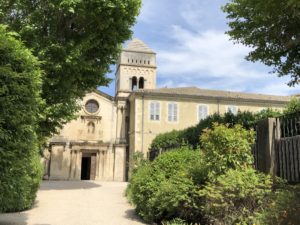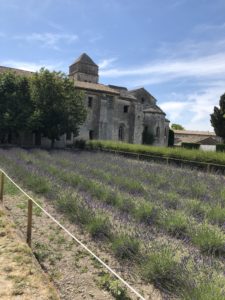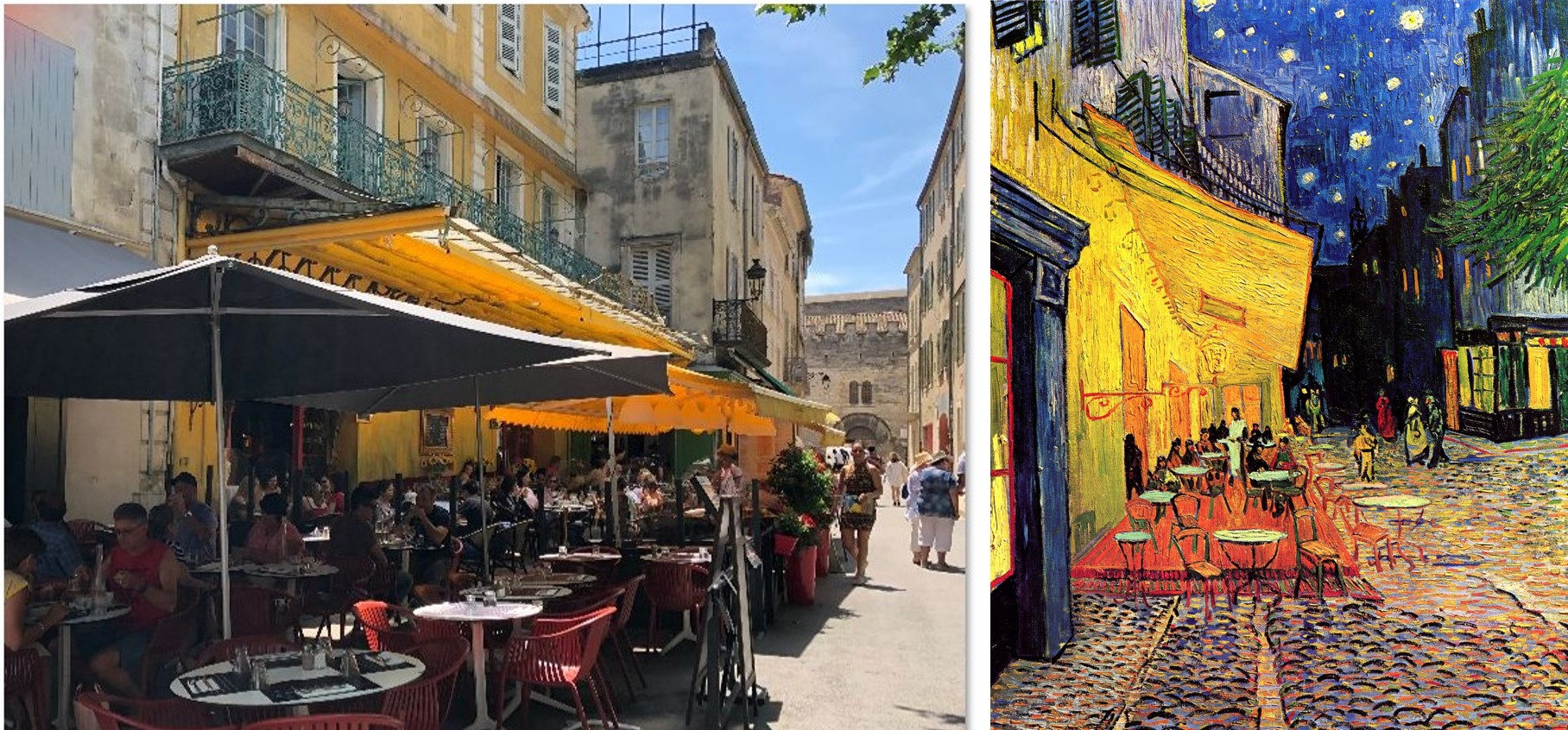I love art and I love to travel: two reasons why I really loved our France’s Finest Viking River Cruise in June. While I go to museums at every opportunity, I don’t often get to walk in the footsteps of artists whose works hang in those museums. This cruise let me do both.
In the southern leg of the trip, from Avignon to Lyon, I was able to walk through the world that inspired Vincent Van Gogh’s paintings. I visited the places he painted, breathed the Provençal air, and bathed in the Mediterranean light that he tried to capture. It was a rare experience.
Painting in Arles
From Viking Heimdal, we traveled south to Arles, where we saw the curve of the Rhône river with its bridges. We noted the place where the Yellow House in which Van Gogh had his room once stood. The building was taken down years ago.
The we walked to a studio, where we painted, copying a Van Gogh picture—or a portion of a picture—in oil. I would love to say that mine came out wonderfully and I now have my very own Van Gogh on the wall. Unfortunately, I did not choose well and was not successful in what I painted. Yes, I brought it home. No, I will not show it to anyone.
Roaming in Arles
 After washing our brushes and the paint from our hands, we explored the Fondation Vincent Van Gogh Arles. This is a very small but very modern art museum on a back street in Arles, taking in their eclectic collection. With lunchtime approaching, we walked through the city to a lovely restaurant. On the way, we saw the square where Van Gogh painted the Yellow Café.
After washing our brushes and the paint from our hands, we explored the Fondation Vincent Van Gogh Arles. This is a very small but very modern art museum on a back street in Arles, taking in their eclectic collection. With lunchtime approaching, we walked through the city to a lovely restaurant. On the way, we saw the square where Van Gogh painted the Yellow Café.
We also saw the church of St. Trophime, where I insisted that we stop for a photo opportunity. Henry Hobson Richardson based his design for the western porch of Boston’s Trinity Church on the façade of St. Trophime and I wanted a picture of me standing on the steps. (That’s me in the white shorts.) After giving so many Back Bay tours for Boston By Foot, I had to pay homage to the original.
Lunch with Julius Caesar
It was hot in Arles that day and stepping into the dining room of the Hotel Jules César was like walking into cool water. We sat down and had a delicious, leisurely lunch marked by good conversation with our guide and the hotel staff. This kind of experience is typical of a Viking River Cruise, where you meet and get to know wonderful people from all over the world.
Then we went off to explore other Van Gogh inspirations around Arles, including the convent cloister. We also saw Les Arènes, the Roman amphitheater that is still used for (non-violent) performances today.
Visiting the Hospital
 After that came what I consider the highlight of the trip: driving to the hospital of St. Paul de Mausole in St. Rémy de Provence. This is where Vincent Van Gogh voluntarily committed himself in May of 1889 to regain his mental health.
After that came what I consider the highlight of the trip: driving to the hospital of St. Paul de Mausole in St. Rémy de Provence. This is where Vincent Van Gogh voluntarily committed himself in May of 1889 to regain his mental health.
Fortunately for us, his doctors considered painting to be therapeutic and Van Goah was allowed to paint in the hospital and to roam the hills around it with his easel.
The hospital is built around a monastery that goes back to the Gallo-Roman Era, when a natural spring brought people to seek a cure from Valetudo, the goddess of health. In the 11th century, the Christians built a priory near the spring that is a gem of Provençal Romansque art.
A Year of Creative Genius
 This short time in Saint Rémy is considered a major period in the works of Van Gogh. Supported by the care of doctors, nurses, and nuns, he created 143 oil paintings and more than 100 drawings in just 53 weeks. These include such iconic works as:
This short time in Saint Rémy is considered a major period in the works of Van Gogh. Supported by the care of doctors, nurses, and nuns, he created 143 oil paintings and more than 100 drawings in just 53 weeks. These include such iconic works as:
- “The Irises”
- “Starry Night”
- “Olive Orchard “
- “Wheatfield with Cypress”
- “The First Steps”
- “Wheatfield with a Reaper”
- “La Sieste”
- “Garden in the St-Paul hospice”
- “Vase with Iris”
- “Vincent’s Room in Arles”
“Les Alpilles” – the Limestone Hills
I always through that the twisting, organic hills in Van Gogh’s works from this period were a product of his fervid imagination. To my surprise, I discovered that the hills actually look like that. The are called “Les Alpilles,” or the little Alps, and they constitute a small limestone massif that rises from the farmland between Rhone and Durance. The jagged white hills point chaotically upward with bluish shadows. Les Alpilles have been weathered into crags and caves that have housed people for thousands of years and contain the ruins of castles. Van Gogh got it right.
 The hospital itself is beautiful, with a Romanesque cloister, a chapel, and a garden filled with rows of lavender. The tour guide showed us around including some of the patients’ rooms. I could understand why the Provencal light captivated so many artists.
The hospital itself is beautiful, with a Romanesque cloister, a chapel, and a garden filled with rows of lavender. The tour guide showed us around including some of the patients’ rooms. I could understand why the Provencal light captivated so many artists.
What the artworks can’t convey is the smell of sun-warmed air filled with the scents of pine, oak and cypress trees, olive groves and vineyards, and lavender fields. It is fresh, fragrant, wild, and alluring all at the same time.
A Van Gogh Open-Air Museum
We were all tired during the return ride but still engrossed by the little towns—and more vineyards—that we passed on the way. I felt like I had spent the day in an open-air museum, looking not at the paintings but through the frames at the locations and the artifacts that had inspired them.
I had enjoyed a rare experience that took art off the walls of staid museums and made it real, visceral, and immediate.
When we got home from our cruise, I went out and bought a pot of lavender. It thrived in the hot sun outside and now is wintering over under the south window of our dining room. It’s my little bit of Provence in New England.


